Seat Exeo 2008 Owner's manual
Manufacturer: SEAT, Model Year: 2008, Model line: Exeo, Model: Seat Exeo 2008Pages: 303, PDF Size: 10.02 MB
Page 241 of 303
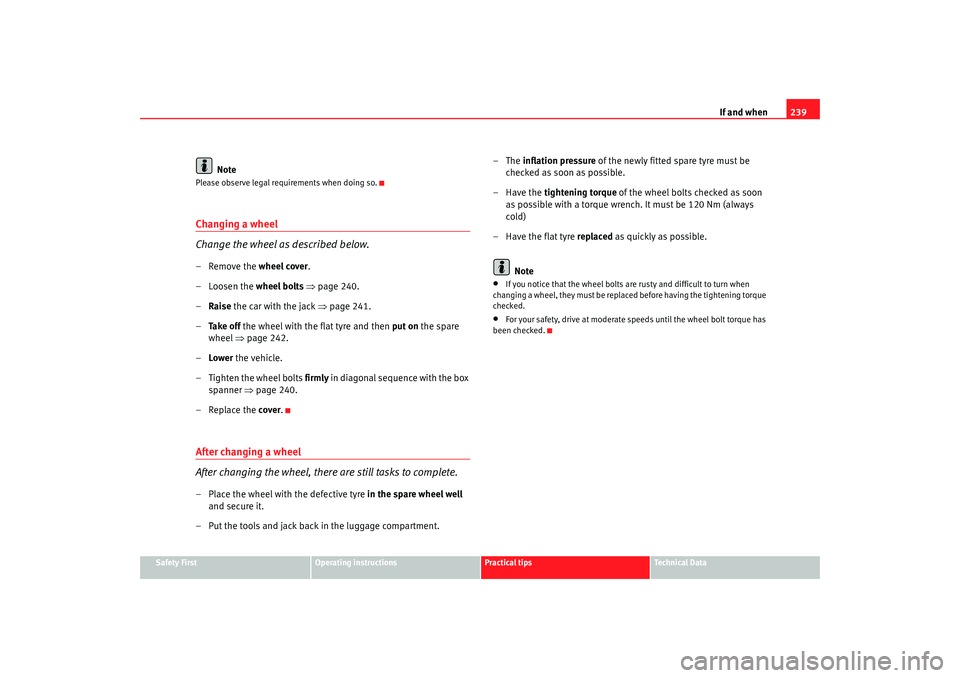
If and when239
Safety First
Operating instructions
Practical tips
Te c h n i c a l D a t a
Note
Please observe legal requirements when doing so.Changing a wheel
Change the wheel as described below.– Remove the wheel cover.
– Loosen the wheel bolts ⇒ page 240.
– Raise the car with the jack ⇒ page 241.
– Ta k e o f f the wheel with the flat tyre and then put on the spare
wheel ⇒page 242.
– Lower the vehicle.
– Tighten the wheel bolts firmly in diagonal sequence with the box
spanner ⇒page 240.
–Replace the cover.After changing a wheel
After changing the wheel, there are still tasks to complete.– Place the wheel with the defective tyre in the spare wheel well
and secure it.
– Put the tools and jack back in the luggage compartment. –The
inflation pressure of the newly fitted spare tyre must be
checked as soon as possible.
– Have the tightening torque of the wheel bolts checked as soon
as possible with a torque wrench. It must be 120 Nm (always
cold)
– Have the flat tyre replaced as quickly as possible.
Note
•
If you notice that the wheel bolts are rusty and difficult to turn when
changing a wheel, they must be replaced before having the tightening torque
checked.
•
For your safety, drive at moderate speeds until the wheel bolt torque has
been checked.
Exeo_EN.book Seite 239 Freitag, 17. Oktober 2008 11:24 11
Page 242 of 303
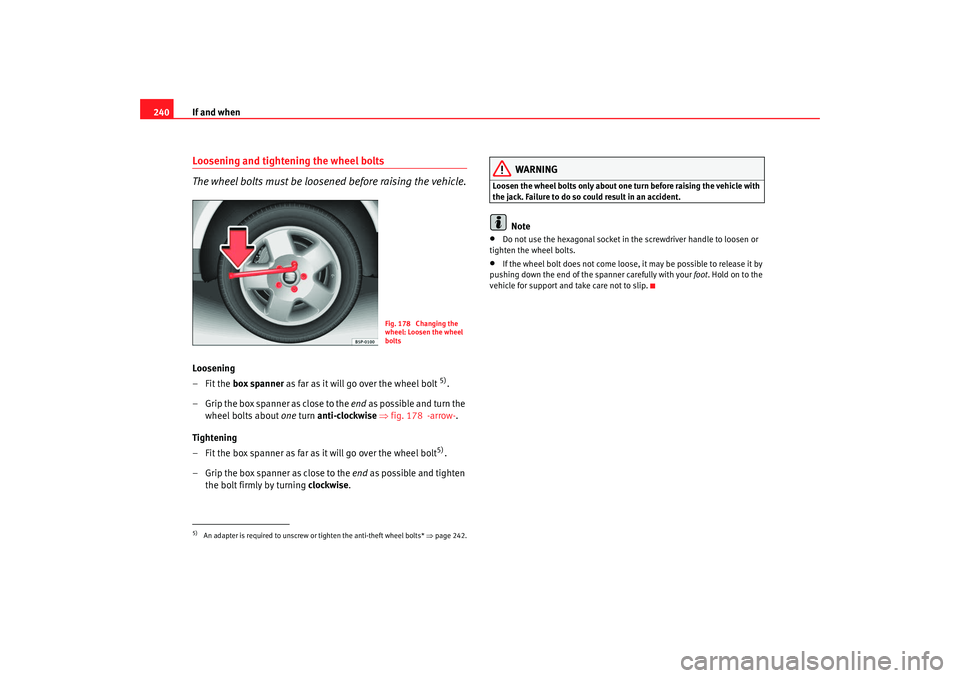
If and when
240Loosening and tightening the wheel bolts
The wheel bolts must be loosened before raising the vehicle.Loosening
–Fit the box spanner as far as it will go over the wheel bolt
5).
– Grip the box spanner as close to the end as p ossible a nd tu rn the
wheel bolts about one turn anti-clockwise ⇒ fig. 178 -arrow- .
Tightening
– Fit the box spanner as far as it will go over the wheel bolt5).
– Grip the box spanner as close to the end as possible and tighten
the bolt firmly by turning clockwise.
WARNING
Loosen the wheel bolts only about one tu rn before raising the vehicle with
the jack. Failure to do so could result in an accident.
Note
•
Do not use the hexagonal socket in the screwdriver handle to loosen or
tighten the wheel bolts.
•
If the wheel bolt does not come loose, it may be possible to release it by
pushing down the end of the spanner carefully with your foot. Hold on to the
vehicle for support and take care not to slip.
5)An adapter is required to unscrew or tighten the anti-theft wheel bolts* ⇒page 242.
Fig. 178 Changing the
wheel: Loosen the wheel
bolts
Exeo_EN.book Seite 240 Freitag, 17. Oktober 2008 11:24 11
Page 243 of 303

If and when241
Safety First
Operating instructions
Practical tips
Te c h n i c a l D a t a
Raising the vehicle
In order to remove the wheel, the vehicle must be raised with
a jack.
– Position the vehicle jack under the door sill at the jacking point
closest to the wheel being changed ⇒fig. 179 -arrows- .
–Wind up the jack under the jacking point until the claw of the jack
is directly below the vertical rib under the door sill.
– Align the jack so that the arm of the jack fits on the rib under the door sill ⇒fig. 180 and the movable base plate of the jack
is flat on the ground.
– Raise the vehicle until the defect ive wheel is just clear of the
ground.Recesses at the front and rear of the door sills mark the jacking points
⇒ fig. 179 -arrows- . There is only one jacking point for each wheel. Do not fit
the jack anywhere else.
The distance from the jacking points to the wheel arches is approximately 15
cm at the front and 25 cm at the rear.
An unstable surface under the jack may cause the vehicle to slip off the jack.
Therefore, the jack must be fitted on solid ground offering good support. Use
a large, stable base if necessary. On a hard, slippery surface (such as tiles)
use a rubber mat or similar to prevent the jack from slipping.
WARNING
•
Take all precautions so that the base of the jack does not slip. Failure to
do so could result in an accident.
•
The vehicle can be damaged if the jack is not applied at the correct
jacking points. There is also a risk of injury since the jack can slip off
suddenly if it is not properly engaged.
Fig. 179 Changing the
wheel: The jacking pointsFig. 180 Changing the
wheel: Jack
AA
AB
Exeo_EN.book Seite 241 Freitag, 17. Oktober 2008 11:24 11
Page 244 of 303
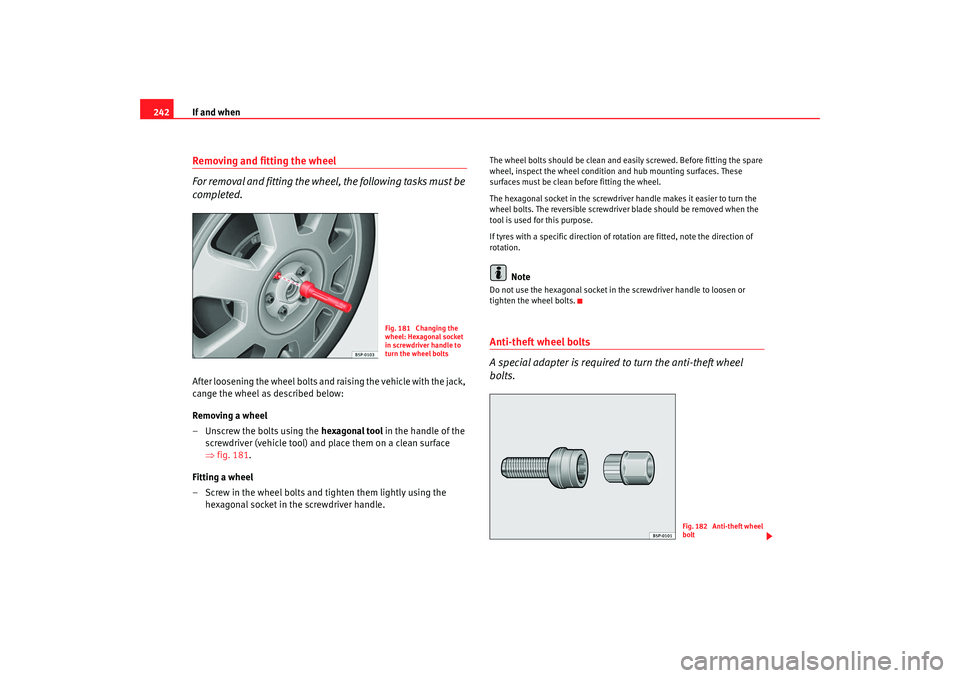
If and when
242Removing and fitting the wheel
For removal and fitting the wheel, the following tasks must be
completed.After loosening the wheel bolts and raising the vehicle with the jack,
cange the wheel as described below:
Removing a wheel
– Unscrew the bolts using the hexagonal tool in the handle of the
screwdriver (vehicle tool) and place them on a clean surface
⇒ fig. 181.
Fitting a wheel
– Screw in the wheel bolts and tighten them lightly using the hexagonal socket in the screwdriver handle.
The wheel bolts should be clean and easily screwed. Before fitting the spare
wheel, inspect the wheel condition and hub mounting surfaces. These
surfaces must be clean before fitting the wheel.
The hexagonal socket in the screwdriver handle makes it easier to turn the
wheel bolts. The reversible screwdriver blade should be removed when the
tool is used for this purpose.
If tyres with a specific di rection of rotation are fitt ed, note the direction of
rotation.
Note
Do not use the hexagonal socket in the screwdriver handle to loosen or
tighten the wheel bolts.Anti-theft wheel bolts
A special adapter is required to turn the anti-theft wheel
bolts.
Fig. 181 Changing the
wheel: Hexagonal socket
in screwdriver handle to
turn the wheel bolts
Fig. 182 Anti-theft wheel
bolt
Exeo_EN.book Seite 242 Freitag, 17. Oktober 2008 11:24 11
Page 245 of 303

If and when243
Safety First
Operating instructions
Practical tips
Te c h n i c a l D a t a
– Insert the adapter onto the wheel bolt and push it on as far as it
will go ⇒page 242, fig. 182 .
– Fit the box spanner as far as it will go over the adapter.
– Loosen or tighten the wheel bolt as appropriate.Error code
The code number of the anti-t heft wheel bolt is stamped onto the front part of
the adaptor.
The code number should be noted and kept in a safe place, as it is only by
using the code number that a duplicat e adaptor can be obtained from an
Authorised Service Centre.Tyres with directional tread pattern
Tyres with directional tread pattern must be fitted so that they
rotate in the correct direction.A directional tread pattern can be identified by arrows on the sidewall that
point in the direction of rotation. Always note the direction of rotation indi-
cated when fitting the wheel. This is important so that these tyres can give
maximum grip and avoid excessive noise, tread wear and aquaplaning.
If, in an emergency, you have to fit th e spare wheel so it rotates in the wrong
direction, you must drive extremely care fully. The tyre will not give optimum
performance. This is particularly important when driving on wet roads.
To benefit from the advantages of tyres with this type of tread pattern, the
defective tyre should be replaced as soon as possible so that all tyres again
rotate in the correct direction.
Tyre repair* (Tyre-Mobility-System)General information and safety notes
Repaired tyres are only suitable for temporary use over a
short period.Your vehicle is equipped with a tyre repair kit: the Tyre Mobility System.
In the event of a puncture you will find the TMS, which consists of a sealing
compound and a compressor, located under the floor panel in the luggage
compartment.
The Tyre Mobility System will reliably seal tyres damaged by foreign bodies,
provided that the cuts or punctu res are no larger than approx. 4 mm in diam-
eter.
It is not necessary to remove the foreign body from the tyre.
Fig. 183 The Tyre
Mobility System is not
suitable for repairing this
type of damage to tyres.
Exeo_EN.book Seite 243 Freitag, 17. Oktober 2008 11:24 11
Page 246 of 303
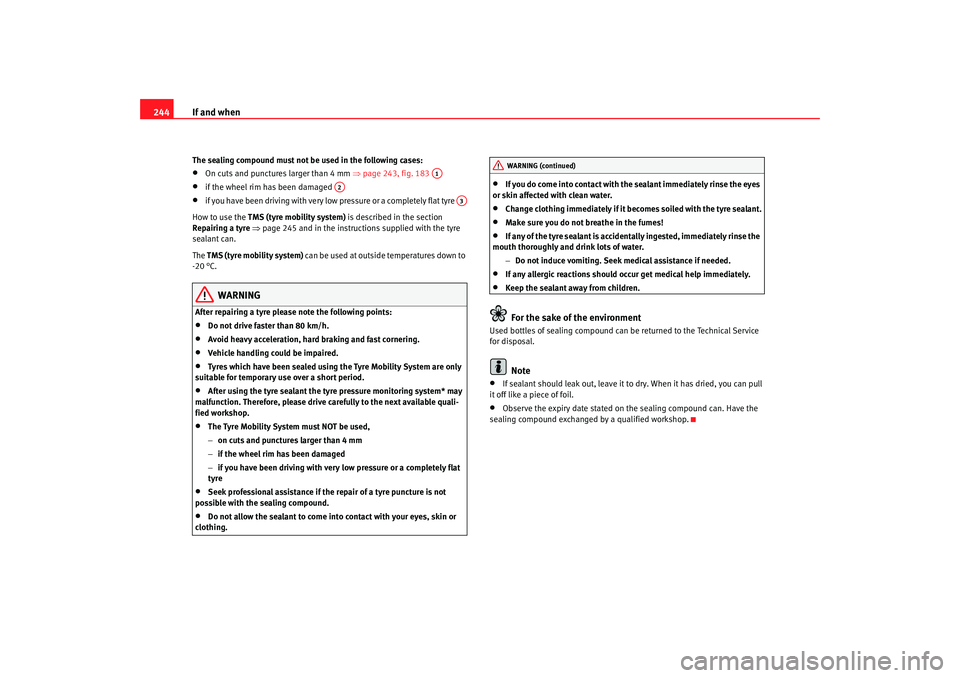
If and when
244The sealing compound must not be used in the following cases:•
On cuts and punctures larger than 4 mm ⇒page 243, fig. 183
•
if the wheel rim has been damaged
•
if you have been driving with very low pressure or a completely flat tyre
How to use the TMS (tyre mobility system) is described in the section
Repairing a tyre ⇒ page 245 and in the instructions supplied with the tyre
sealant can.
The TMS (tyre mobility system) can be used at outside temperatures down to
-20 °C.
WARNING
After repairing a tyre please note the following points:•
Do not drive faster than 80 km/h.
•
Avoid heavy acceleration, hard braking and fast cornering.
•
Vehicle handling could be impaired.
•
Tyres which have been sealed using the Tyre Mobility System are only
suitable for temporary use over a short period.
•
After using the tyre sealant the tyre pressure monitoring system* may
malfunction. Therefore, please drive carefully to the next available quali-
fied workshop.
•
The Tyre Mobility System must NOT be used,
− on cuts and punctures larger than 4 mm
− if the wheel rim has been damaged
− if you have been driving with very low pressure or a completely flat
tyre
•
Seek professional assistance if the repair of a tyre puncture is not
possible with the sealing compound.
•
Do not allow the sealant to come into contact with your eyes, skin or
clothing.
•
If you do come into contact with the sealant immediately rinse the eyes
or skin affected with clean water.
•
Change clothing immediately if it becomes soiled with the tyre sealant.
•
Make sure you do not breathe in the fumes!
•
If any of the tyre sealant is accidentally ingested, immediately rinse the
mouth thoroughly and drink lots of water.
−Do not induce vomiting. Seek medical assistance if needed.
•
If any allergic reactions should occur get medical help immediately.
•
Keep the sealant away from children.For the sake of the environment
Used bottles of sealing compound can be returned to the Technical Service
for disposal.
Note
•
If sealant should leak out, leave it to dry. When it has dried, you can pull
it off like a piece of foil.
•
Observe the expiry date stated on the sealing compound can. Have the
sealing compound exchanged by a qualified workshop.
A1
A2
A3
WARNING (continued)
Exeo_EN.book Seite 244 Freitag, 17. Oktober 2008 11:24 11
Page 247 of 303
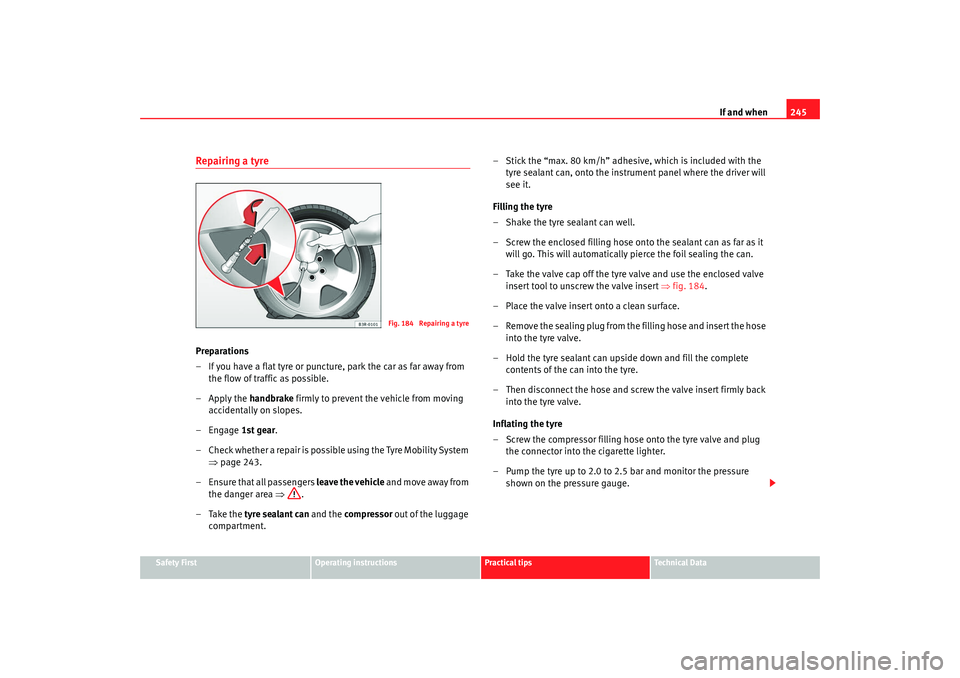
If and when245
Safety First
Operating instructions
Practical tips
Te c h n i c a l D a t a
Repairing a tyrePreparations
– If you have a flat tyre or puncture, park the car as far away from
the flow of traffic as possible.
–Apply the handbrake firmly to prevent the vehicle from moving
accidentally on slopes.
–Engage 1st gear.
– Check whether a repair is possible using the Tyre Mobility System ⇒page 243.
– Ensure that all passengers leave the vehicle and move away from
the danger area ⇒.
– Take the tyre sealant can and the compressor out of the luggage
compartment. – Stick the “max. 80 km/h” adhesive, which is included with the
tyre sealant can, onto the instru ment panel where the driver will
see it.
Filling the tyre
– Shake the tyre sealant can well.
– Screw the enclosed filling hose onto the sealant can as far as it will go. This will automatically pierce the foil sealing the can.
– Take the valve cap off the tyre valve and use the enclosed valve insert tool to unscrew the valve insert ⇒fig. 184.
– Place the valve insert onto a clean surface.
– Remove the sealing plug from the filling hose and insert the hose into the tyre valve.
– Hold the tyre sealant can upside down and fill the complete contents of the can into the tyre.
– Then disconnect the hose and screw the valve insert firmly back into the tyre valve.
Inflating the tyre
– Screw the compressor filling hose onto the tyre valve and plug the connector into the cigarette lighter.
– Pump the tyre up to 2.0 to 2.5 bar and monitor the pressure shown on the pressure gauge.
Fig. 184 Repairing a tyre
Exeo_EN.book Seite 245 Freitag, 17. Oktober 2008 11:24 11
Page 248 of 303
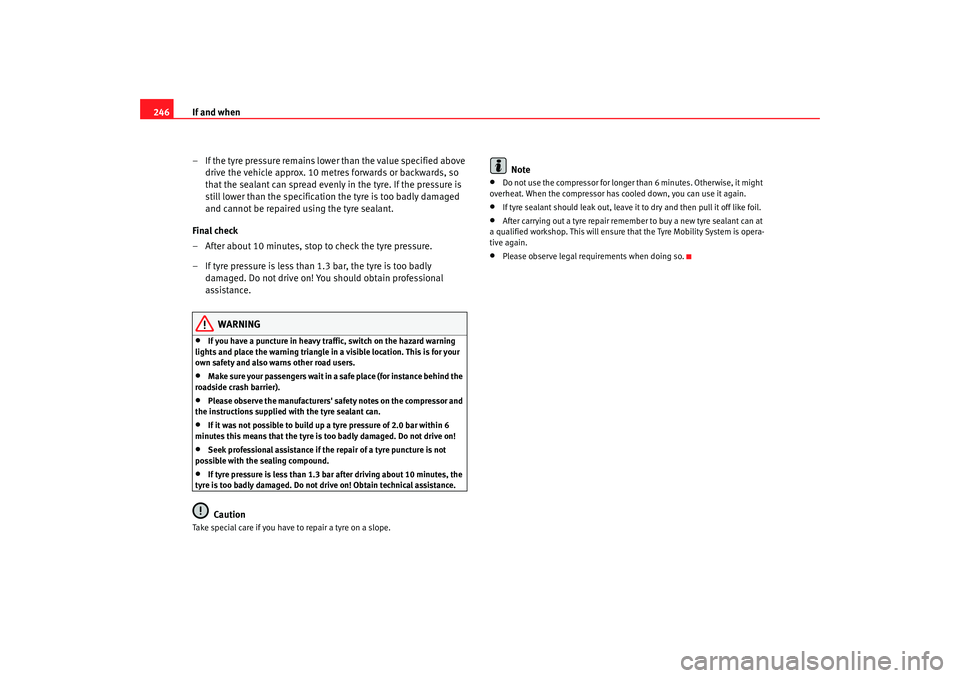
If and when
246
– If the tyre pressure remains lower than the value specified above drive the vehicle approx. 10 metres forwards or backwards, so
that the sealant can spread evenly in the tyre. If the pressure is
still lower than the specification the tyre is too badly damaged
and cannot be repaired using the tyre sealant.
Final check
– After about 10 minutes, stop to check the tyre pressure.
– If tyre pressure is less than 1.3 bar, the tyre is too badly damaged. Do not drive on! You should obtain professional
assistance.
WARNING
•
If you have a puncture in heavy traffic, switch on the hazard warning
lights and place the warning triangle in a visible location. This is for your
own safety and also warns other road users.
•
Make sure your passengers wait in a safe place (for instance behind the
roadside crash barrier).
•
Please observe the manufacturers' safety notes on the compressor and
the instructions supplied with the tyre sealant can.
•
If it was not possible to build up a tyre pressure of 2.0 bar within 6
minutes this means that the tyre is too badly damaged. Do not drive on!
•
Seek professional assistance if the repair of a tyre puncture is not
possible with the sealing compound.
•
If tyre pressure is less than 1.3 bar after driving about 10 minutes, the
tyre is too badly damaged. Do not drive on! Obtain technical assistance.Caution
Take special care if you have to repair a tyre on a slope.
Note
•
Do not use the compressor for longer than 6 minutes. Otherwise, it might
overheat. When the compressor has cooled down, you can use it again.
•
If tyre sealant should leak out, leave it to dry and then pull it off like foil.
•
After carrying out a tyre repair remember to buy a new tyre sealant can at
a qualified workshop. This will ensure that the Tyre Mobility System is opera-
tive again.
•
Please observe legal requirements when doing so.
Exeo_EN.book Seite 246 Freitag, 17. Oktober 2008 11:24 11
Page 249 of 303

If and when247
Safety First
Operating instructions
Practical tips
Te c h n i c a l D a t a
FusesChanging fuses
If a fuse has blown, it must be replaced.
– Switch off the ignition and its failed electrical component.
– Remove the fuse cover using a screwdriver ⇒fig. 185 .
– Identify the fuse for the failed component ⇒page 248, “Fuse
assignment”.
– Take the plastic clip from inside the fuse cover, fit it onto the
blown fuse, and pull the fuse out.
– Replace the blown fuse (which will have a melted metal strip) with a new fuse of the same amp rating.
–Fit the fuse cover back on.The individual electrical circuits are pr otected by fuses. The fuses are located
behind a cover at the left-hand end of the instrument panel.
Two spare fuses and a sticker identifying the fuses are provided on the inside
of the fuse cover. There is also a crank handle for operating the sun roof* by
hand (if the electrical system fails).
Caution
Never “repair” damaged fuses and never replace them with fuses with a
higher rating. Failure to comply could result in fire. It could also cause
damage to other parts of the electrical system.
Note
If a newly replaced fuse blows again after a short time, the electrical system
must be checked by a qualified workshop as soon as possible.
Fig. 185 Left side of dash
panel: Fuse box coverFig. 186 Schematic
drawing of fuse box at the
left-hand end of instru-
ment panel: Fuses
(without fuse cover)
Exeo_EN.book Seite 247 Freitag, 17. Oktober 2008 11:24 11
Page 250 of 303
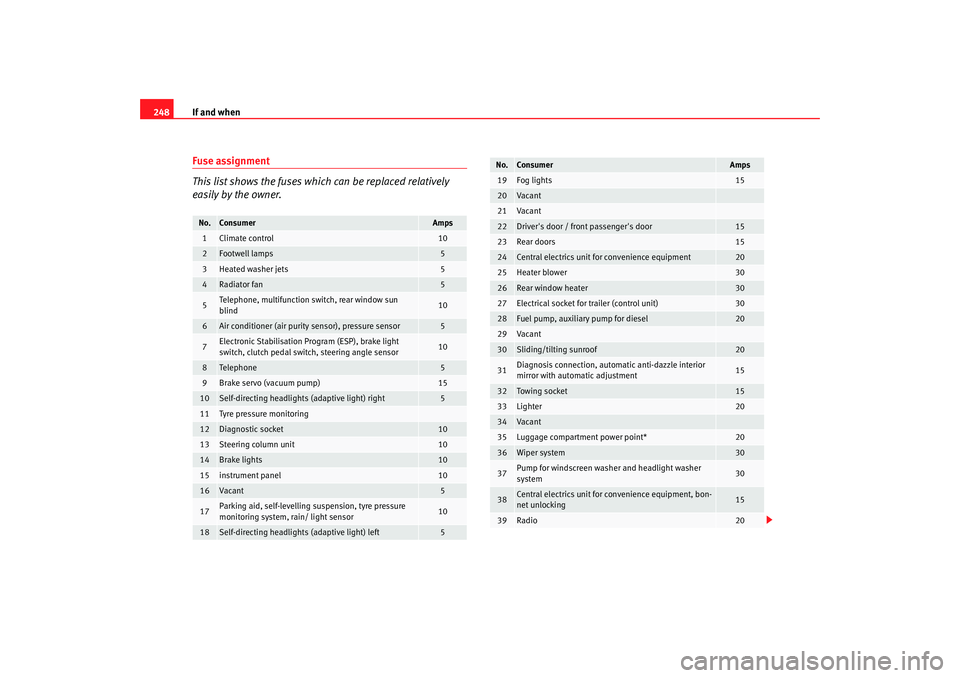
If and when
248Fuse assignment
This list shows the fuses which can be replaced relatively
easily by the owner.No.
Consumer
Amps
1
Climate control
10
2
Footwell lamps
5
3
Heated washer jets
5
4
Radiator fan
5
5
Telephone, multifunction switch, rear window sun
blind
10
6
Air conditioner (air purity sensor), pressure sensor
5
7
Electronic Stabilisation Pro gram (ESP), brake light
switch, clutch pedal switch, steering angle sensor
10
8
Telephone
5
9
Brake servo (vacuum pump)
15
10
Self-directing headlights (adaptive light) right
5
11
Tyre pressure monitoring
12
Diagnostic socket
10
13
Steering column unit
10
14
Brake lights
10
15
instrument panel
10
16
Vacant
5
17
Parking aid, self-levelling suspension, tyre pressure
monitoring system, rain/ light sensor
10
18
Self-directing headlights (adaptive light) left
5
19
Fog lights
15
20
Vacant
21
Vacant
22
Driver's door / front passenger's door
15
23
Rear doors
15
24
Central electrics unit for convenience equipment
20
25
Heater blower
30
26
Rear window heater
30
27
Electrical socket for trailer (control unit)
30
28
Fuel pump, auxiliary pump for diesel
20
29
Vacant
30
Sliding/tilting sunroof
20
31
Diagnosis connection, automatic anti-dazzle interior
mirror with automatic adjustment
15
32
Towing socket
15
33
Lighter
20
34
Vacant
35
Luggage compartment power point*
20
36
Wiper system
30
37
Pump for windscreen washer and headlight washer
system
30
38
Central electrics unit for convenience equipment, bon-
net unlocking
15
39
Radio
20
No.
Consumer
Amps
Exeo_EN.book Seite 248 Freitag, 17. Oktober 2008 11:24 11